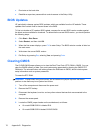
B Diagnostics
Interpreting Diagnostic Beep Codes
The Power-On Self-Test (POST) is a series of diagnostic tests that runs automatically when the
computer is powered on. If the POST detects an error, this causes an audible beep code to sound.
The POST beep codes are not necessarily accompanied by an associated, visble error code or text
message.
The following table shows the POST beep codes, their meanings, and the recommended actions for
solving the problem.
WARNING! When the computer is plugged into an AC power source, voltage is always applied to
the system board. To reduce the risk of personal injury from electrical shock and/or hot surfaces, be
sure to disconnect the power cord from the wall outlet and allow the internal system components to
cool before touching.
Table B-1 Diagnostic Beep Codes
Beeps Diagnosis Recommended action
1 short beep, 1
long beep, 3
second pause
Bad memory or memory
configuration error.
Check that the memory modules have been installed correctly and
that proper modules are used.
2 short beeps, 1
long beep, 3
second pause
No graphics card installed or
graphics card initialization failed.
For systems with a graphics card:
1. Reseat the graphics card. Power on the system.
2. Replace the graphics card.
3. Replace the system board.
For systems with integrated graphics, replace the system board.
3 short beeps, 1
long beep, 3
second pause
CPU configuration error or invalid
CPU detected before graphics card
initialized.
1. Upgrade the BIOS to proper version.
2. Change the processor.
1 short beep, 1
second pause
No legacy floppy drive or optical
drive found
1. Check cable connections.
2. Run the Setup utility and ensure the device port is enabled.
2 short beeps, 3
second pause
No floppy diskette or CD found 1. Check the type of drive you are using and use the correct
media type.
2. Replace the diskette or CD with a new one.
Interpreting Diagnostic Beep Codes
65


















